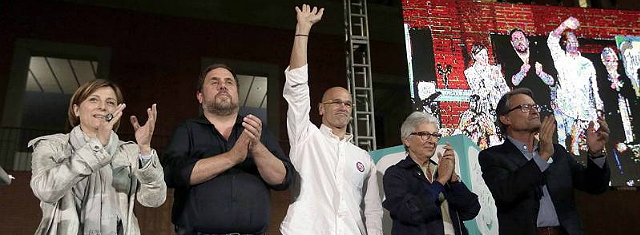Politics
Catalonia says no independence
Sovereignism wins seats but not on votes

The candidates of Junts pel Si, winners (Source: RTVE)
USPA NEWS -
The independence parties won regional elections in Catalonia, held without incident and with high historical participation was around 78%. However, separatist forces obtained less than 48% of the vote.
The outcome of the regional elections in Catalonia raises more questions than it intended to clear. Junts pel Si (Together for the yes), the coalition of the Nationalist Party Convergence of Catalonia and Republican Left (ERC its acronym in Catalan), won the election by obtaining 62 seats out of 135, well above the 25 that won Citizens, the second most voted party. The Socialist Party placed third with 16 seats, while the Popular Party of Spanish Prime Minister, Mariano Rajoy, won 11 seats, the same formation that left Catalonia itself can (CSP for its acronym in Catalan) and CUP -another independentist party- had 10.
However, these results hide a significant loss of popular support for the coalition parties Junts pel Si that separately, in the regional elections of 2012, had added 71 seats. They also lose popular support the Popular Party and CSP, while Citizens goes from 9-25 seats and passes CUP 3-10 seats. The Socialist Party lost four seats, but continues as a third political force in the Catalan Parliament with 16 deputies.
The question now is what will the independence parties. Alone is not enough Junts pel Si an absolute majority in the Catalan Parliament. They need the support of the CUP, but this formation had said during the campaign that the majority of seats is not enough and will not support a constitutional process for the independence of Catalonia without a clear majority. And in votes, the independence movement is a minority with just under 48% of the vote. The independence parties had repeated that interpret these regional elections as a plebiscite and that form of consultation, the majority must be of votes and no seats. However, the CUP leaders called for civil disobedience of the Spanish laws after the results of elections.
Still in the maelstrom of election night winners and feeling, the independence parties were quick to give other clues about their next steps. "For years we have been working to have an explicit mandate on independence and tonight we have now," said the leader of ERC, Oriol Junqueras. "We have enough to continue the majority," he added. "We are writing the most glorious pages of our history." For his part, the president of the Catalan Government yet and number 4 on the list of Junts pel Si, Artur Mas, wondered: "All those who denied the plebiscitary nature of these elections, what will they say now? With almost a 80% share, clearly a plebiscite."
Against these interpretations, from Madrid, Secretary of Communication of the Popular Party, Pablo Casado, he said "the separatist challenge has failed." Conservative leader in opinion, "the majority of Catalans rejected independence. A census of 5.5 million Catalans, it seems that only 1.8 million have backed the independence parties." With these data, the PP believes the Catalan separatist parties are not entitled to initiate an independence process. To amend the Statute of Autonomy, reminded Pablo Casado, "it takes 2/3 of the Parliament and separatist parties are very far from achieving that number."
In the same sense, the secretary general of the Socialist Party PSOE, Pedro Sanchez, who said that "those who said they lost these elections were a referendum was expressed. There is a majority of Catalans who do not want independence but want a dialogue is opened. Catalonia is broken," said the Socialist leader, before adding: "Junts pel Si has obtained the majority confidence of the citizens of Catalonia, but not to continue causing problems. The new Government of Catalonia must heal the wounds that have been opened five years."
Liability for this article lies with the author, who also holds the copyright. Editorial content from USPA may be quoted on other websites as long as the quote comprises no more than 5% of the entire text, is marked as such and the source is named (via hyperlink).





